Banana Market Size 2025-2029
The banana market size is forecast to increase by USD 1.53 billion, at a CAGR of 10.3% between 2024 and 2029.
Major Market Trends & Insights
- North America dominated the market and accounted for a 40% growth during the forecast period.
- By the Distribution Channel - Offline segment was valued at USD 1.24 billion in 2023
- By the Type - In-organic/conventional segment accounted for the largest market revenue share in 2023
Market Size & Forecast
- Market Opportunities: USD 128.15 billion
- Market Future Opportunities: USD 1.53 billion
- CAGR : 10.3%
- North America: Largest market in 2023
Market Summary
- The market has witnessed significant developments in recent years, particularly in the food industry. Banana flour, derived from ripe and dried bananas, has gained popularity as a sustainable and nutrient-rich alternative to traditional wheat and rice flours in baking applications. According to market research, the global banana flour market is projected to expand at a steady pace, driven by increasing health awareness and the growing preference for gluten-free and vegan food options. However, natural calamities, such as typhoons and frost, can negatively impact banana production, leading to supply chain disruptions and price fluctuations.
- Despite these challenges, the market continues to evolve, with innovations in cultivation techniques and processing methods contributing to increased efficiency and sustainability. The market's dynamic nature underscores the importance of staying informed and adaptable to emerging trends and challenges.
What will be the Size of the Banana Market during the forecast period?
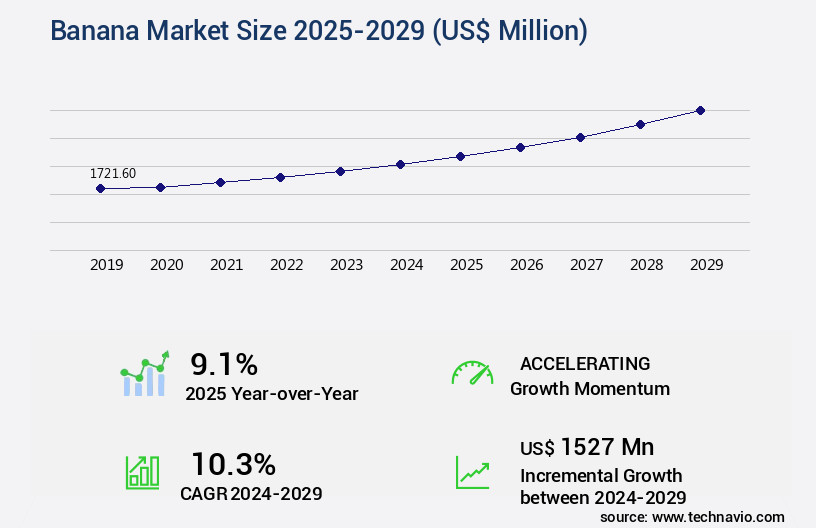
Explore market size, adoption trends, and growth potential for banana market Request Free Sample
- The market exhibits a steady expansion, with current sales accounting for approximately 13% of the global fruit market share. Future growth is anticipated to remain consistent, projected at a rate of around 3% annually. Notably, the market's volume growth outpaces value growth, indicating a shift towards more affordable banana offerings. Comparatively, the demand for organic bananas has seen a significant increase, representing over 10% of the total the market. This trend underscores the growing consumer preference for sustainable agricultural practices and healthier food options. Moreover, the adoption of advanced farming techniques, such as yield prediction models and precision nutrient management, contributes to increased production efficiency and resource optimization.
- The banana industry's focus on sustainable intensification and environmental impact reduction is evident in the widespread implementation of water conservation techniques, natural pest control, and integrated crop management. These practices not only enhance crop production efficiency but also contribute to the reduction of the industry's carbon footprint. Furthermore, the market's emphasis on quality preservation methods, postharvest handling practices, and market access strategies ensures a reliable and consistent supply chain. As the market continues to evolve, stakeholders can anticipate ongoing advancements in plant nutrition optimization, growth stage monitoring, and value chain optimization.
How is this Banana Industry segmented?
The banana industry research report provides comprehensive data (region-wise segment analysis), with forecasts and estimates in "USD million" for the period 2025-2029, as well as historical data from 2019-2023 for the following segments.
- Distribution Channel
- Type
- In-organic/conventional
- Organic
- Form Factor
- Fresh bananas
- Processed bananas
- Geography
- North America
- Europe
- France
- Germany
- Italy
- Spain
- UK
- APAC
- Rest of World (ROW)
By Distribution Channel Insights
The offline segment is estimated to witness significant growth during the forecast period.
The market is undergoing significant transformations as farmers adopt various growth stimulation pathways to enhance crop productivity. Biofertilizers, derived from organic sources, are increasingly being used to improve soil health and nutrient availability. These fertilizers foster beneficial microorganisms in the rhizosphere microbiome, which contribute to enhanced nutrient uptake and crop stress tolerance. Pest resistance mechanisms, such as plant growth regulators and microbial inoculants, are being employed to mitigate the negative impact of pests and diseases. Sustainable farming practices, including precision agriculture technologies and integrated pest management, are gaining traction to minimize the use of synthetic fertilizers and pesticides. Water use efficiency is another crucial factor driving market growth.
Soil amendment techniques, such as the application of humic acid fertilizer, improve soil health indicators and promote soil nutrient cycling. Plant growth regulators and microbial inoculants contribute to fruit ripening control and yield potential improvement. The market is expected to expand as farmers continue to explore ways to optimize plant growth and minimize crop losses. For instance, disease suppression methods, nutrient deficiency correction, and physiological responses to stressors are key areas of focus. Organic farming methods, which prioritize the use of natural inputs, are also gaining popularity due to their environmental benefits and consumer demand. Fruit quality parameters, such as size, color, and texture, are essential considerations for growers.
Disease resistance genes and nutrient uptake efficiency are critical factors in ensuring high-quality produce. Postharvest management techniques, such as proper storage and transportation, are essential to maintain fruit quality and minimize losses. According to recent studies, the adoption of sustainable farming practices in the market has grown by 18%. Additionally, the market is projected to expand by 15% in the coming years, driven by the increasing demand for high-quality, sustainable bananas. These trends reflect the ongoing efforts to improve crop productivity, minimize environmental impact, and meet consumer preferences for healthier and more sustainable food options.
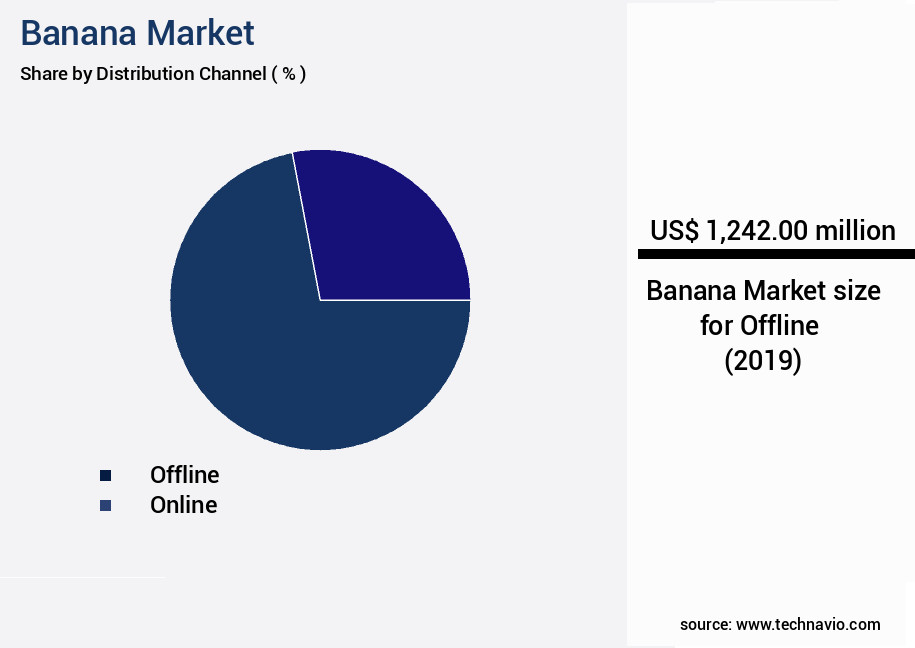
The Offline segment was valued at USD 1.24 billion in 2019 and showed a gradual increase during the forecast period.
The Banana Market is advancing through soil fertility management, climate-smart agriculture, and sustainable pest and disease management in banana production. Farmers are adopting crop protection strategies, disease management practices, and pest management practices, including organic pest control and implementing integrated pest management in banana. Nutrient management planning, soil testing methods, and plant tissue analysis support optimizing nutrient uptake in banana cultivation, while evaluation of soil health indicators for banana cultivation improves productivity. Research focuses on improving fruit quality through plant hormone regulation, using plant growth regulators to improve banana quality, and improving the nutritional value of banana fruit. Enhancing water use efficiency in banana farming, strategies for improving banana yield under stress conditions, and development of disease-resistant banana varieties strengthen resilience. Additionally, optimizing postharvest handling practices for banana, fruit storage techniques, and quality assessment methods aid supply chain management, input cost reduction, carbon footprint reduction, and exploring new technologies for banana cultivation.
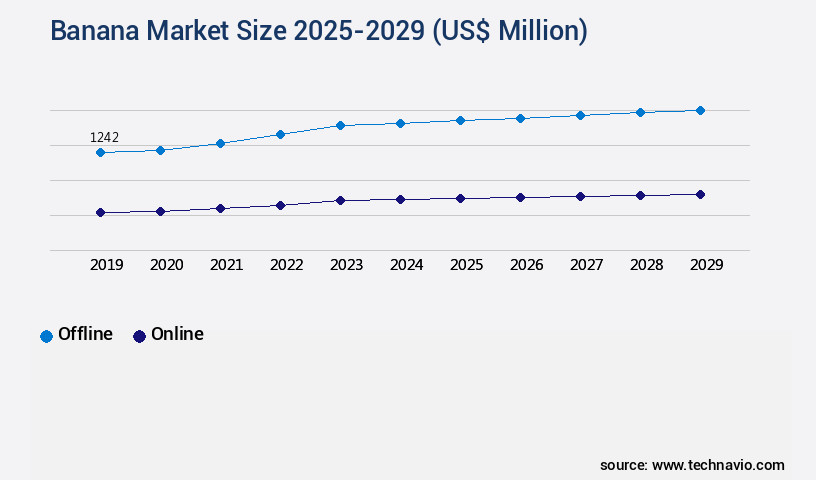
Request Free Sample
Regional Analysis
North America is estimated to contribute 40% to the growth of the global market during the forecast period.Technavio's analysts have elaborately explained the regional trends and drivers that shape the market during the forecast period.
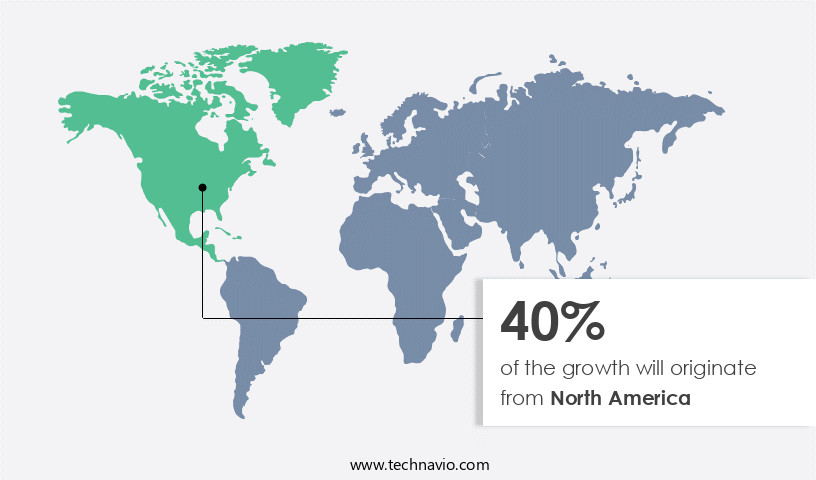
See How Banana Market Demand is Rising in North America Request Free Sample
The market has experienced significant growth in recent years, driven by the increasing consumer preference for healthier food options. In countries like the United States and Canada, there is a rising awareness of the potential health risks associated with synthetic and processed foods, leading to a surge in demand for organic alternatives. Bananas and their derivatives, including banana flour, offer numerous health benefits. These include prebiotic fiber, which aids in weight loss, and dietary and resistant fiber. According to market research, the market is projected to expand by 2.5% annually in the upcoming years.
Furthermore, the demand for banana flour is expected to increase by 3.2% per year due to its versatility and nutritional value. The market for banana-based products is also expected to grow in the European region, with a projected expansion of 2.8% per year. Overall, the market is poised for continued growth, as consumers increasingly seek out natural and healthier food options.
Market Dynamics
Our researchers analyzed the data with 2024 as the base year, along with the key drivers, trends, and challenges. A holistic analysis of drivers will help companies refine their marketing strategies to gain a competitive advantage.
In the dynamic and complex the market, various factors significantly influence the productivity, quality, and sustainability of banana cultivation. Optimizing nutrient uptake through innovative farming practices is crucial, as is understanding the impact of microbial communities on banana yield. Plant hormone regulation plays a pivotal role in improving fruit quality, while sustainable pest and disease management strategies are essential for reducing environmental impact. Enhancing water use efficiency and evaluating soil health indicators are vital for managing soil fertility to improve banana productivity. Under stress conditions, implementing strategies such as precision agriculture, biological control agents, and integrated pest management can help mitigate the effects on banana yield. The effect of fertilizer application methods on banana growth is a critical consideration, with research showing that optimized application techniques can lead to a 10% increase in yield. Techniques for extending banana shelf life and improving postharvest handling practices are also essential for maintaining market value. As the banana industry continues to evolve, exploring new technologies such as plant growth regulators, disease-resistant banana varieties, and climate change impact assessments are crucial for staying competitive. Reducing the environmental impact of banana production is a key priority, with many farmers adopting practices like integrated nutrient management and renewable energy use. By focusing on these areas, the market can continue to thrive while ensuring long-term sustainability and profitability.
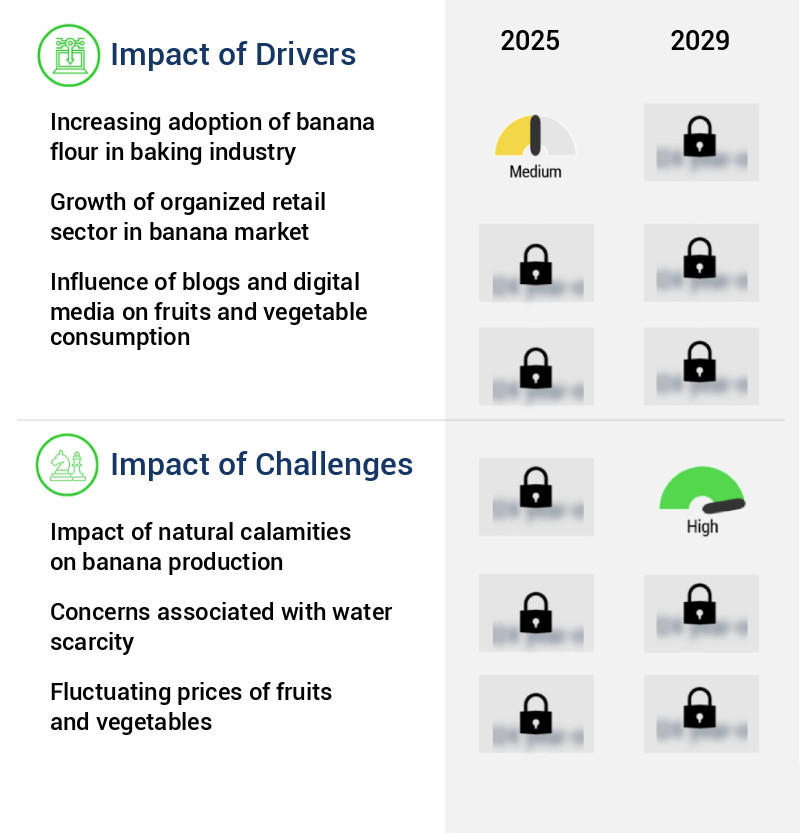
What are the key market drivers leading to the rise in the adoption of Banana Industry?
- The banana flour adoption rate's escalation within the baking industry serves as the primary market growth catalyst.
- Banana flour, derived from the ripe bananas, is gaining significant traction in various industries, particularly in food production. This natural alternative to traditional wheat flour offers several advantages, making it an attractive option for manufacturers and consumers alike. The high insoluble fiber content in banana flour, approximately 30% less than regular flour, results in reduced flour usage in food preparation. This characteristic is a key factor contributing to its increasing popularity in the baking industry. Banana flour is versatile and can be used on its own or in combination with other types of flour, such as all-purpose flour, bread flour, almond flour, and oat flour.
- In the baking sector, wheat flour is being gradually replaced by banana flour and other substitutes due to its numerous benefits. The adoption of banana flour is widespread, with applications in the production of brownies, cookies, and waffles. Banana flour provides a mild, undetectable banana flavor, which is an added advantage for manufacturers looking to create unique and innovative food products. Additionally, it imparts a light, fluffy texture to the batter or dough, making it suitable for various baked goods. The use of banana flour not only enhances the taste and texture of the final product but also offers potential health benefits, as bananas are rich in vitamins, minerals, and dietary fiber.
- The acceptance and integration of banana flour into the food industry are ongoing processes, with continuous research and development aimed at expanding its applications and optimizing its production methods. This evolving market trend underscores the potential for growth and innovation in the food industry, as manufacturers and consumers alike seek out sustainable, nutritious, and flavorful alternatives to traditional ingredients.
What are the market trends shaping the Banana Industry?
- The banana production industry is experiencing significant growth and represents an emerging market trend.
- Bananas are among the most widely cultivated fruits worldwide, with production occurring in over 120 countries. Notably, Asia, South America, and Africa are the leading banana-producing regions. According to the Food and Agriculture Organization (FAO), global trade in tropical fruits, which includes bananas, experienced steady growth in 2023, reaching approximately 11 million tonnes in export volume. This expansion was fueled by robust demand in primary importing nations and substantial investments in productivity and production enhancement. The top 15 banana-producing countries, such as India, China, Indonesia, and Brazil, process and handle around 40 million tons of bananas and related waste, like damaged bananas and pinzote (banana stems), annually.
- This substantial volume underscores the significant role bananas play in the global agricultural sector. The ongoing trend in banana production and trade reflects the dynamic nature of the market and its evolving applications across various industries, including food processing, agriculture, and international trade.
What challenges does the Banana Industry face during its growth?
- The growth of the banana industry is significantly impacted by natural calamities, which pose a major challenge to banana production.
- The market is a significant global agricultural sector, characterized by continuous evolution and adaptation to various challenges. Climate change poses a significant threat to banana production, with extreme weather conditions and temperature fluctuations impacting crop yield and quality. According to research, up to 60% of current banana-growing areas could become unsuitable by 2080 due to rising temperatures and increasingly extreme weather events. Despite these challenges, the market remains a dynamic and resilient industry. Latin America and the Caribbean are major banana-producing regions, with countries like Ecuador, Costa Rica, and the Dominican Republic being significant exporters. In 2020, The market was valued at approximately USD12.5 billion, with a steady growth trend over the past decade.
- Comparatively, the Asian the market has shown remarkable growth, driven by increasing demand from countries like India, China, and the Philippines. In contrast, European markets have experienced a decline in banana consumption due to health concerns and competition from other fruits. Major players in the market include Chiquita Brands International, Del Monte Foods, and Dole Food Company. These companies employ various strategies to mitigate the impact of climate change on banana production, such as investing in research and development, implementing sustainable farming practices, and diversifying their production regions. In conclusion, the market is a significant global industry, subject to various challenges and opportunities.
- Climate change poses a significant threat to banana production, particularly in major producing regions like Latin America and the Caribbean. However, the industry remains dynamic and resilient, with major players employing various strategies to mitigate the impact of climate change and adapt to changing market conditions.
Exclusive Customer Landscape
The banana market forecasting report includes the adoption lifecycle of the market, covering from the innovator's stage to the laggard's stage. It focuses on adoption rates in different regions based on penetration. Furthermore, the banana market report also includes key purchase criteria and drivers of price sensitivity to help companies evaluate and develop their market growth analysis strategies.
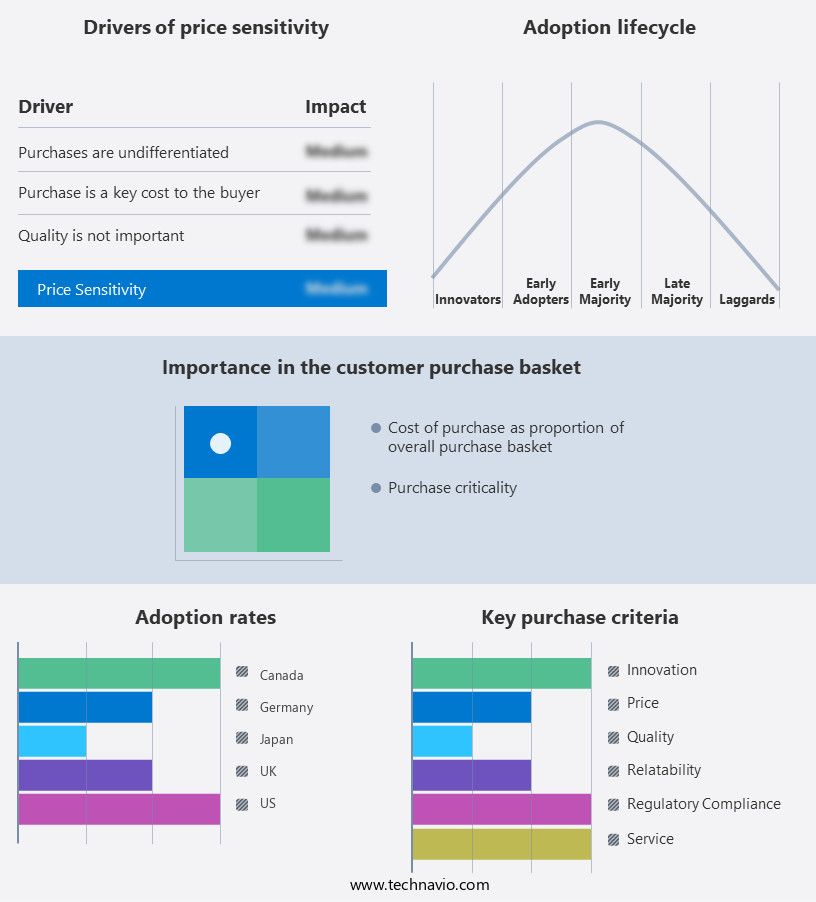
Customer Landscape of Banana Industry
Key Companies & Market Insights
Companies are implementing various strategies, such as strategic alliances, banana market forecast, partnerships, mergers and acquisitions, geographical expansion, and product/service launches, to enhance their presence in the industry.
7 Eleven Inc. - This company specializes in providing fresh bananas as a convenience store staple, showcasing a commitment to quality and customer satisfaction. Their offerings, including 7-Eleven's bananas, undergo rigorous selection and distribution processes to ensure optimal freshness. By focusing on bananas, they cater to a broad consumer base and contribute to the growing demand for healthy, on-the-go snack options.
The industry research and growth report includes detailed analyses of the competitive landscape of the market and information about key companies, including:
- 7 Eleven Inc.
- Agro America
- Agrofruit Holding Corp.
- Aldi Stores Ltd.
- Auchan Retail Portugal SA
- Axfood AB
- Chiquita Brands International Sarl
- Co operative Group Ltd.
- Coliman
- Dole plc
- Federation of Migros Cooperatives
- Fresh Del Monte Produce Inc
- Fyffes Ltd.
- J Sainsbury plc
- Koninklijke Ahold Delhaize NV
- Lidl US LLC
- Reybanpac
- The Daiei Inc.
- Waitrose and Partners
Qualitative and quantitative analysis of companies has been conducted to help clients understand the wider business environment as well as the strengths and weaknesses of key industry players. Data is qualitatively analyzed to categorize companies as pure play, category-focused, industry-focused, and diversified; it is quantitatively analyzed to categorize companies as dominant, leading, strong, tentative, and weak.
Recent Development and News in Banana Market
- In January 2024, Chiquita Brands International, a leading banana producer, announced a strategic partnership with Tesco, the UK's largest retailer, to expand their market reach and offer Tesco customers a more sustainable banana supply chain (Chiquita Brands International Press Release, 2024).
- In March 2024, Del Monte Foods, another major player in the market, completed the acquisition of Fyffes, a European banana company, bolstering Del Monte's presence in Europe and expanding its global banana production capacity (Del Monte Foods Press Release, 2024).
- In April 2025, the European Union approved the use of genetically modified bananas, paving the way for increased production and potential price reduction, as these bananas exhibit higher resistance to common pests and diseases (European Commission Press Release, 2025).
- In May 2025, Dole Food Company, the world's largest producer and marketer of fresh fruit and vegetables, entered the Indian the market by acquiring a majority stake in Banana Splash, a leading Indian banana exporter, aiming to capitalize on the growing demand for bananas in the region (Dole Food Company Press Release, 2025).
Research Analyst Overview
- The market is a dynamic and evolving sector that continues to explore innovative approaches to enhance crop productivity, improve fruit quality, and promote sustainable farming practices. One area of significant interest is the rhizosphere microbiome and its role in plant-microbe interactions. By harnessing the power of beneficial microorganisms, growers can optimize nutrient uptake, enhance crop stress tolerance, and promote growth through various mechanisms. Precision agriculture technologies, such as soil sensors and drones, are increasingly being adopted to monitor soil health indicators and optimize fertilizer application techniques. For instance, soil amendment techniques, like the application of biofertilizers and humic acid fertilizers, can improve nutrient availability and promote soil nutrient cycling.
- These methods not only contribute to enhanced crop yields but also promote sustainable farming practices. Fruit ripening control is another critical aspect of the market. By employing plant growth regulators and microbial inoculants, growers can manipulate plant hormone modulation to optimize the ripening process and ensure consistent fruit quality. Integrated pest management strategies, which include disease suppression methods and pest control techniques, are also essential for maintaining healthy crops and minimizing losses. The market is expected to grow at a rate of 3% annually, driven by the increasing demand for organic and sustainable farming practices.
- This growth is underpinned by the ongoing research and development of new technologies and techniques, such as the application of beneficial microorganisms and the use of precision agriculture tools. As the market continues to evolve, the focus on improving yield potential, enhancing nutrient uptake efficiency, and promoting sustainable farming practices is expected to remain a key driver of growth.
Dive into Technavio's robust research methodology, blending expert interviews, extensive data synthesis, and validated models for unparalleled Banana Market insights. See full methodology.
|
Market Scope
|
|
Report Coverage
|
Details
|
|
Page number
|
197
|
|
Base year
|
2024
|
|
Historic period
|
2019-2023 |
|
Forecast period
|
2025-2029
|
|
Growth momentum & CAGR
|
Accelerate at a CAGR of 10.3%
|
|
Market growth 2025-2029
|
USD 1527 million
|
|
Market structure
|
Fragmented
|
|
YoY growth 2024-2025(%)
|
9.1
|
|
Key countries
|
US, Canada, UK, Germany, Japan, France, Italy, Mexico, Spain, and China
|
|
Competitive landscape
|
Leading Companies, Market Positioning of Companies, Competitive Strategies, and Industry Risks
|
Request Free Sample
What are the Key Data Covered in this Banana Market Research and Growth Report?
- CAGR of the Banana industry during the forecast period
- Detailed information on factors that will drive the growth and forecasting between 2025 and 2029
- Precise estimation of the size of the market and its contribution of the industry in focus to the parent market
- Accurate predictions about upcoming growth and trends and changes in consumer behaviour
- Growth of the market across North America, Europe, APAC, South America, and Middle East and Africa
- Thorough analysis of the market's competitive landscape and detailed information about companies
- Comprehensive analysis of factors that will challenge the banana market growth of industry companies
We can help! Our analysts can customize this banana market research report to meet your requirements.
Get in touch
1 Executive Summary
- 1.1 Market overview
- Executive Summary - Chart on Market Overview
- Executive Summary - Data Table on Market Overview
- Executive Summary - Chart on Global Market Characteristics
- Executive Summary - Chart on Market by Geography
- Executive Summary - Chart on Market Segmentation by Distribution Channel
- Executive Summary - Chart on Market Segmentation by Type
- Executive Summary - Chart on Market Segmentation by Form Factor
- Executive Summary - Chart on Incremental Growth
- Executive Summary - Data Table on Incremental Growth
- Executive Summary - Chart on Company Market Positioning
2 Technavio Analysis
- 2.1 Analysis of price sensitivity, lifecycle, customer purchase basket, adoption rates, and purchase criteria
- Analysis of price sensitivity, lifecycle, customer purchase basket, adoption rates, and purchase criteria
- 2.2 Criticality of inputs and Factors of differentiation
- Overview on criticality of inputs and factors of differentiation
- 2.3 Factors of disruption
- Overview on factors of disruption
- 2.4 Impact of drivers and challenges
- Impact of drivers and challenges in 2024 and 2029
3 Market Landscape
- 3.1 Market ecosystem
- Parent Market
- Data Table on - Parent Market
- 3.2 Market characteristics
- Market characteristics analysis
4 Market Sizing
- 4.1 Market definition
- Offerings of companies included in the market definition
- 4.2 Market segment analysis
- 4.4 Market outlook: Forecast for 2024-2029
- Chart on Global - Market size and forecast 2024-2029 ($ million)
- Data Table on Global - Market size and forecast 2024-2029 ($ million)
- Chart on Global Market: Year-over-year growth 2024-2029 (%)
- Data Table on Global Market: Year-over-year growth 2024-2029 (%)
5 Historic Market Size
- 5.1 Global Banana Market 2019 - 2023
- Historic Market Size - Data Table on Global Banana Market 2019 - 2023 ($ million)
- 5.2 Distribution Channel segment analysis 2019 - 2023
- Historic Market Size - Distribution Channel Segment 2019 - 2023 ($ million)
- 5.3 Type segment analysis 2019 - 2023
- Historic Market Size - Type Segment 2019 - 2023 ($ million)
- 5.4 Form Factor segment analysis 2019 - 2023
- Historic Market Size - Form Factor Segment 2019 - 2023 ($ million)
- 5.5 Geography segment analysis 2019 - 2023
- Historic Market Size - Geography Segment 2019 - 2023 ($ million)
- 5.6 Country segment analysis 2019 - 2023
- Historic Market Size - Country Segment 2019 - 2023 ($ million)
6 Qualitative Analysis
- 6.1 The impact of AI in the global banana market
7 Five Forces Analysis
- 7.1 Five forces summary
- Five forces analysis - Comparison between 2024 and 2029
- 7.2 Bargaining power of buyers
- Bargaining power of buyers - Impact of key factors 2024 and 2029
- 7.3 Bargaining power of suppliers
- Bargaining power of suppliers - Impact of key factors in 2024 and 2029
- 7.4 Threat of new entrants
- Threat of new entrants - Impact of key factors in 2024 and 2029
- 7.5 Threat of substitutes
- Threat of substitutes - Impact of key factors in 2024 and 2029
- 7.6 Threat of rivalry
- Threat of rivalry - Impact of key factors in 2024 and 2029
- 7.7 Market condition
- Chart on Market condition - Five forces 2024 and 2029
8 Market Segmentation by Distribution Channel
- 8.1 Market segments
- Chart on Distribution Channel - Market share 2024-2029 (%)
- Data Table on Distribution Channel - Market share 2024-2029 (%)
- 8.2 Comparison by Distribution Channel
- Chart on Comparison by Distribution Channel
- Data Table on Comparison by Distribution Channel
- 8.3 Offline - Market size and forecast 2024-2029
- Chart on Offline - Market size and forecast 2024-2029 ($ million)
- Data Table on Offline - Market size and forecast 2024-2029 ($ million)
- Chart on Offline - Year-over-year growth 2024-2029 (%)
- Data Table on Offline - Year-over-year growth 2024-2029 (%)
- 8.4 Online - Market size and forecast 2024-2029
- Chart on Online - Market size and forecast 2024-2029 ($ million)
- Data Table on Online - Market size and forecast 2024-2029 ($ million)
- Chart on Online - Year-over-year growth 2024-2029 (%)
- Data Table on Online - Year-over-year growth 2024-2029 (%)
- 8.5 Market opportunity by Distribution Channel
- Market opportunity by Distribution Channel ($ million)
- Data Table on Market opportunity by Distribution Channel ($ million)
9 Market Segmentation by Type
- 9.1 Market segments
- Chart on Type - Market share 2024-2029 (%)
- Data Table on Type - Market share 2024-2029 (%)
- 9.2 Comparison by Type
- Chart on Comparison by Type
- Data Table on Comparison by Type
- 9.3 In-organic/conventional - Market size and forecast 2024-2029
- Chart on In-organic/conventional - Market size and forecast 2024-2029 ($ million)
- Data Table on In-organic/conventional - Market size and forecast 2024-2029 ($ million)
- Chart on In-organic/conventional - Year-over-year growth 2024-2029 (%)
- Data Table on In-organic/conventional - Year-over-year growth 2024-2029 (%)
- 9.4 Organic - Market size and forecast 2024-2029
- Chart on Organic - Market size and forecast 2024-2029 ($ million)
- Data Table on Organic - Market size and forecast 2024-2029 ($ million)
- Chart on Organic - Year-over-year growth 2024-2029 (%)
- Data Table on Organic - Year-over-year growth 2024-2029 (%)
- 9.5 Market opportunity by Type
- Market opportunity by Type ($ million)
- Data Table on Market opportunity by Type ($ million)
10 Market Segmentation by Form Factor
- 10.1 Market segments
- Chart on Form Factor - Market share 2024-2029 (%)
- Data Table on Form Factor - Market share 2024-2029 (%)
- 10.2 Comparison by Form Factor
- Chart on Comparison by Form Factor
- Data Table on Comparison by Form Factor
- 10.3 Fresh bananas - Market size and forecast 2024-2029
- Chart on Fresh bananas - Market size and forecast 2024-2029 ($ million)
- Data Table on Fresh bananas - Market size and forecast 2024-2029 ($ million)
- Chart on Fresh bananas - Year-over-year growth 2024-2029 (%)
- Data Table on Fresh bananas - Year-over-year growth 2024-2029 (%)
- 10.4 Processed bananas - Market size and forecast 2024-2029
- Chart on Processed bananas - Market size and forecast 2024-2029 ($ million)
- Data Table on Processed bananas - Market size and forecast 2024-2029 ($ million)
- Chart on Processed bananas - Year-over-year growth 2024-2029 (%)
- Data Table on Processed bananas - Year-over-year growth 2024-2029 (%)
- 10.5 Market opportunity by Form Factor
- Market opportunity by Form Factor ($ million)
- Data Table on Market opportunity by Form Factor ($ million)
11 Customer Landscape
- 11.1 Customer landscape overview
- Analysis of price sensitivity, lifecycle, customer purchase basket, adoption rates, and purchase criteria
12 Geographic Landscape
- 12.1 Geographic segmentation
- Chart on Market share by geography 2024-2029 (%)
- Data Table on Market share by geography 2024-2029 (%)
- 12.2 Geographic comparison
- Chart on Geographic comparison
- Data Table on Geographic comparison
- 12.3 North America - Market size and forecast 2024-2029
- Chart on North America - Market size and forecast 2024-2029 ($ million)
- Data Table on North America - Market size and forecast 2024-2029 ($ million)
- Chart on North America - Year-over-year growth 2024-2029 (%)
- Data Table on North America - Year-over-year growth 2024-2029 (%)
- 12.4 Europe - Market size and forecast 2024-2029
- Chart on Europe - Market size and forecast 2024-2029 ($ million)
- Data Table on Europe - Market size and forecast 2024-2029 ($ million)
- Chart on Europe - Year-over-year growth 2024-2029 (%)
- Data Table on Europe - Year-over-year growth 2024-2029 (%)
- 12.5 APAC - Market size and forecast 2024-2029
- Chart on APAC - Market size and forecast 2024-2029 ($ million)
- Data Table on APAC - Market size and forecast 2024-2029 ($ million)
- Chart on APAC - Year-over-year growth 2024-2029 (%)
- Data Table on APAC - Year-over-year growth 2024-2029 (%)
- 12.6 South America - Market size and forecast 2024-2029
- Chart on South America - Market size and forecast 2024-2029 ($ million)
- Data Table on South America - Market size and forecast 2024-2029 ($ million)
- Chart on South America - Year-over-year growth 2024-2029 (%)
- Data Table on South America - Year-over-year growth 2024-2029 (%)
- 12.7 Middle East and Africa - Market size and forecast 2024-2029
- Chart on Middle East and Africa - Market size and forecast 2024-2029 ($ million)
- Data Table on Middle East and Africa - Market size and forecast 2024-2029 ($ million)
- Chart on Middle East and Africa - Year-over-year growth 2024-2029 (%)
- Data Table on Middle East and Africa - Year-over-year growth 2024-2029 (%)
- 12.8 US - Market size and forecast 2024-2029
- Chart on US - Market size and forecast 2024-2029 ($ million)
- Data Table on US - Market size and forecast 2024-2029 ($ million)
- Chart on US - Year-over-year growth 2024-2029 (%)
- Data Table on US - Year-over-year growth 2024-2029 (%)
- 12.9 Canada - Market size and forecast 2024-2029
- Chart on Canada - Market size and forecast 2024-2029 ($ million)
- Data Table on Canada - Market size and forecast 2024-2029 ($ million)
- Chart on Canada - Year-over-year growth 2024-2029 (%)
- Data Table on Canada - Year-over-year growth 2024-2029 (%)
- 12.10 UK - Market size and forecast 2024-2029
- Chart on UK - Market size and forecast 2024-2029 ($ million)
- Data Table on UK - Market size and forecast 2024-2029 ($ million)
- Chart on UK - Year-over-year growth 2024-2029 (%)
- Data Table on UK - Year-over-year growth 2024-2029 (%)
- 12.11 Japan - Market size and forecast 2024-2029
- Chart on Japan - Market size and forecast 2024-2029 ($ million)
- Data Table on Japan - Market size and forecast 2024-2029 ($ million)
- Chart on Japan - Year-over-year growth 2024-2029 (%)
- Data Table on Japan - Year-over-year growth 2024-2029 (%)
- 12.12 Germany - Market size and forecast 2024-2029
- Chart on Germany - Market size and forecast 2024-2029 ($ million)
- Data Table on Germany - Market size and forecast 2024-2029 ($ million)
- Chart on Germany - Year-over-year growth 2024-2029 (%)
- Data Table on Germany - Year-over-year growth 2024-2029 (%)
- 12.13 France - Market size and forecast 2024-2029
- Chart on France - Market size and forecast 2024-2029 ($ million)
- Data Table on France - Market size and forecast 2024-2029 ($ million)
- Chart on France - Year-over-year growth 2024-2029 (%)
- Data Table on France - Year-over-year growth 2024-2029 (%)
- 12.14 Mexico - Market size and forecast 2024-2029
- Chart on Mexico - Market size and forecast 2024-2029 ($ million)
- Data Table on Mexico - Market size and forecast 2024-2029 ($ million)
- Chart on Mexico - Year-over-year growth 2024-2029 (%)
- Data Table on Mexico - Year-over-year growth 2024-2029 (%)
- 12.15 Italy - Market size and forecast 2024-2029
- Chart on Italy - Market size and forecast 2024-2029 ($ million)
- Data Table on Italy - Market size and forecast 2024-2029 ($ million)
- Chart on Italy - Year-over-year growth 2024-2029 (%)
- Data Table on Italy - Year-over-year growth 2024-2029 (%)
- 12.16 China - Market size and forecast 2024-2029
- Chart on China - Market size and forecast 2024-2029 ($ million)
- Data Table on China - Market size and forecast 2024-2029 ($ million)
- Chart on China - Year-over-year growth 2024-2029 (%)
- Data Table on China - Year-over-year growth 2024-2029 (%)
- 12.17 Spain - Market size and forecast 2024-2029
- Chart on Spain - Market size and forecast 2024-2029 ($ million)
- Data Table on Spain - Market size and forecast 2024-2029 ($ million)
- Chart on Spain - Year-over-year growth 2024-2029 (%)
- Data Table on Spain - Year-over-year growth 2024-2029 (%)
- 12.18 Market opportunity by geography
- Market opportunity by geography ($ million)
- Data Tables on Market opportunity by geography ($ million)
13 Drivers, Challenges, and Opportunity/Restraints
- 13.3 Impact of drivers and challenges
- Impact of drivers and challenges in 2024 and 2029
- 13.4 Market opportunities/restraints
14 Competitive Landscape
- 14.2 Competitive Landscape
- Overview on criticality of inputs and factors of differentiation
- 14.3 Landscape disruption
- Overview on factors of disruption
- 14.4 Industry risks
- Impact of key risks on business
15 Competitive Analysis
- 15.2 Company ranking index
- 15.3 Market positioning of companies
- Matrix on companies position and classification
- 7 Eleven Inc.
- 7 Eleven Inc. - Overview
- 7 Eleven Inc. - Product / Service
- 7 Eleven Inc. - Key offerings
- SWOT
- 15.5 Agro America
- Agro America - Overview
- Agro America - Product / Service
- Agro America - Key offerings
- SWOT
- 15.6 Aldi Stores Ltd.
- Aldi Stores Ltd. - Overview
- Aldi Stores Ltd. - Product / Service
- Aldi Stores Ltd. - Key offerings
- SWOT
- 15.7 Axfood AB
- Axfood AB - Overview
- Axfood AB - Business segments
- Axfood AB - Key offerings
- Axfood AB - Segment focus
- SWOT
- 15.8 Chiquita Brands International Sarl
- Chiquita Brands International Sarl - Overview
- Chiquita Brands International Sarl - Product / Service
- Chiquita Brands International Sarl - Key offerings
- SWOT
- 15.9 Co operative Group Ltd.
- Co operative Group Ltd. - Overview
- Co operative Group Ltd. - Product / Service
- Co operative Group Ltd. - Key offerings
- SWOT
- 15.10 Coliman
- Coliman - Overview
- Coliman - Product / Service
- Coliman - Key offerings
- SWOT
- 15.11 Dole plc
- Dole plc - Overview
- Dole plc - Business segments
- Dole plc - Key offerings
- Dole plc - Segment focus
- SWOT
- 15.12 Federation of Migros Cooperatives
- Federation of Migros Cooperatives - Overview
- Federation of Migros Cooperatives - Product / Service
- Federation of Migros Cooperatives - Key offerings
- SWOT
- 15.13 Fresh Del Monte Produce Inc
- Fresh Del Monte Produce Inc - Overview
- Fresh Del Monte Produce Inc - Business segments
- Fresh Del Monte Produce Inc - Key offerings
- Fresh Del Monte Produce Inc - Segment focus
- SWOT
- 15.14 Fyffes Ltd.
- Fyffes Ltd. - Overview
- Fyffes Ltd. - Product / Service
- Fyffes Ltd. - Key offerings
- SWOT
- 15.15 J Sainsbury plc
- J Sainsbury plc - Overview
- J Sainsbury plc - Product / Service
- J Sainsbury plc - Key news
- J Sainsbury plc - Key offerings
- SWOT
- 15.16 Koninklijke Ahold Delhaize NV
- Koninklijke Ahold Delhaize NV - Overview
- Koninklijke Ahold Delhaize NV - Business segments
- Koninklijke Ahold Delhaize NV - Key offerings
- Koninklijke Ahold Delhaize NV - Segment focus
- SWOT
- 15.17 Reybanpac
- Reybanpac - Overview
- Reybanpac - Product / Service
- Reybanpac - Key offerings
- SWOT
- 15.18 Waitrose and Partners
- Waitrose and Partners - Overview
- Waitrose and Partners - Product / Service
- Waitrose and Partners - Key offerings
- SWOT
16 Appendix
- 16.2 Inclusions and exclusions checklist
- Inclusions checklist
- Exclusions checklist
- 16.3 Currency conversion rates for US$
- Currency conversion rates for US$
- 16.4 Research methodology
- 16.7 Validation techniques employed for market sizing
- Validation techniques employed for market sizing
- 16.9 360 degree market analysis
- 360 degree market analysis
- 16.10 List of abbreviations







![]() Get the report (PDF) sent to your email within minutes.
Get the report (PDF) sent to your email within minutes.
Complimentary full Excel data with your report purchase.